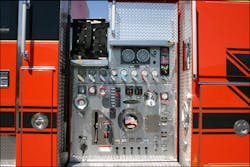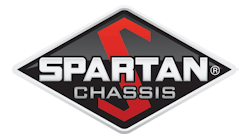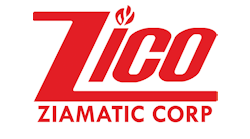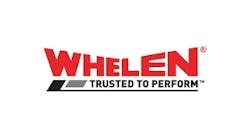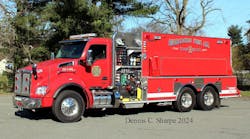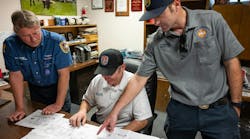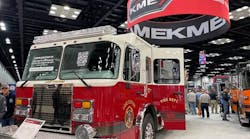So far in our Innovative Rigs on the Street series we have visited locations in California, Maryland and Pennsylvania to identify innovative pieces of apparatus that have been well designed to serve their respective communities.
In this installment we have traveled to the Shenandoah Valley area of Virginia to the city of Winchester which has a rich history dating back to 1729 when the first settlement was established. By 1738 the area had become known as Fredrick Town and in 1750 the area became known as Winchester in honor of Colonel James Wood's home town of Winchester, England.
Today the City of Winchester covers 9.3 square miles and has approximately 23,585 year-round residents. Winchester is the county seat of Fredrick County and is home to Shenandoah University and, since 1924, has hosted the annual Apple Blossom Festival which includes a massive parade of both vintage and modern fire apparatus during the last week of April.
The Winchester Fire Department protects the community operating from four fire stations with a combination of career and volunteer staffing. Engine company service is provided by the Shawnee Fire Company #4 and the South End Fire Company #5, each of which operate two engines and several medic units. The Charley Rouss Fire Company #2 operates two ladder trucks including a Pierce Dash 75-foot single-axle rear-mount ladder as well as a Spartan Gladiator/LTI 105-foot tandem axle rear-mount aerial as Ladder 2.
Our Innovative Rig on the Street this month can be found at the Friendship Fire Company #1 which is located on Pleasant Valley Road on Winchester's north side. The Friendship Fire Company was founded in 1831 and over the years has operated with a unique and varied fleet of engine apparatus including a 1951 Mack L model 750-gpm pumper and a 1967 American LaFrance 900 series 1,000-gpm pumper. During 1982 the fire company took delivery of a Seagrave HB model pumper that was one of 11 units built by Seagrave with forward facing open jump seats. A second Seagrave HB model four-door cab engine was delivered in 1987 followed by the present Wagon 1 a 1997 Seagrave TB-50DA pumper equipped with a 1,500-gpm pump with a 750-gallon water tank. The Friendship Fire Company is under the command of Chief Bobby Luttrell and during 2009 the station responded to 2,091 alarms.
Friendship Fire Company apparatus over the years has featured a number of different color schemes including white over red, white over orange with the newer apparatus painted in a distinctive black over orange color. The new Engine 1 was designed by the members of the fire company's truck committee working closely with the local Pierce representative Jim Darr. The Pierce Arrow XT apparatus has some unique features including an FDNY style painted steel reinforced front bumper and low mounted crosslay attack lines. The engine is built on a 191-inch wheelbase with an overall length of 31 feet, 5 inches. The cab has a 10-inch raised roof design while maintaining an overall height of 118 inches.
The apparatus is powered by a Cummins model ISL engine rated at 425 horsepower using an Allison EVS-3000 five-speed automatic transmission. The front axle is a Meritor FL-943 rated for 19,500 pounds with a Meritor RS26-185 rear axle rated at 27,000 pounds. The apparatus is equipped with 17-inch disc brakes on both the front and rear axles with a Jacobs engine brake utilized for auxiliary braking. The Arrow XT 67-inch cab provides seating for six personnel with five seats equipped with secured SCBA brackets for the protection of the crew.
The front bumper is equipped with a 5-inch front suction with a swivel as well as a 2 1/2-inch front trash line that carries 200 feet of 1 3/4-inch attack line in a recessed hose well. In order to provide sufficient room for these components as well as the audible warning devices a 22-inch bumper extension was required. By locating the front suction swivel out to the far right corner of the bumper this provided sufficient room to recess mount the Federal mechanical siren, both air horns and the electronic siren speaker outboard of the frame rails.
The apparatus warning light package consists of a three Whelen roof-mounted LED light bars together with both 600 series and 700 series Whelen LED lights along the upper and lower portions of the cab and body. Additional front warning lights consist of twin pedestal mounted Mars lights together with a roto-ray. Whelen LED strip lights are located in the rub rails under the side body compartments to provide additional side warning lighting with Whelen LED beacon lights mounted high at the rear of the body. Zico dock lights are provided behind the rear wheels on each side to illuminate this area.
Twelve-volt scene lighting is provided at the front of the cab with a Whelen Pioneer brow light and twin telescopic lights at the rear of the cab. A single Whelen Pioneer LED light is recess mounted at the rear body panel below the hosebed. The rear hose body is finished with black and orange chevron stripping together with a recessed Safety Vision back-up camera. Additional safety lighting includes amber color LED flashing lights located inside of each cab door.
The firefighting capability on Engine 1 is provided by a Hale QFLO single-stage pump rated at 1,250-gpm which can supply any one of the six pre-connect and four pump panel discharges. The two crosslays are equipped with 200 feet of 1 3/4-inch hose that are positioned nine inches lower to the ground. Each of the pre-connected hose lines are color coded both on the pump panel on the gauge and the controlling gate, and in addition have verbiage such as "Blitz Line," "Drivers Rear Pre-connect" and "Attack Monitor" to identify the individual preconnected line. The apparatus is equipped with three 2 1/2-inch hose bed discharges to supply a 300-foot 1 3/4-inch attack line, a 200-foot 2 1/2-inch attack line equipped with a smooth bore nozzle as well as a 200-foot 2 1/2-inch line for a tailboard gun. As the apparatus is provided with a total of five pre-connected attack lines in addition to the pre-connected Akron wagon pipe the importance of a 1,000 gallon water tank are readily apparent during initial attack operations.
The rear hose bed also carries 1,200 feet of 4-inch supply line and 400 feet of 3-inch hose which can be used as a leader line to extend the pre-connected lines and for supplying sprinkler and standpipe connections. A 4-inch gated discharge with a hand wheel control is provided at the right side pump panel. A single booster reel is mounted above the fire pump on the right side and carries 150 feet of 3/4-inch booster hose. The engine has the capability of taking suction from both sides as well as the front intake using Hale master intake valve on both the front and right side 6-inch steamer inlet. All of the pump controls and instrumentation fit into a compact 45-inch wide panel which was well laid out for function and operations.
The aluminum body is 161 inches long and equipped with nine enclosed body compartments utilizing a mixture of adjustable shelves, dividers and PAC tool boards to accommodate all of the tools and appliances. Ground ladders are carried on the right side of the body and include the standard pumper compliment of a 10-foot folding, 14-foot roof and 24-foot extension ladders mounted on a Ziamatic Quic Lift. Stainless steel scuff plates are provided at each of the cab doors, the lower rear body panels as well as the upper body adjacent to the hose bed to protect the paint finish in these areas. The front of the hose bed is equipped with an aluminum tread plate step and wind deflector. Access to the hose bed is provided by a series of fixed aluminum tread plate steps at the left corner of the body.
The Friendship Fire Company's new Pierce Arrow XT Engine 1 is a fine example of a well thought out piece of apparatus with full compliment of attack lines, supply hose, tools and equipment to safely carry out any mission that might be assigned to the unit.
I would like to thank Chief Bobby Luttrell and Jim Darr who assisted with technical information on this apparatus. A special thank you to Mike Sanders for his assistance with photographs of this unit at the Friendship Fire Company.
See Tom Shand Live: Tom will be presenting the following sessions at Firehouse Expo in Baltimore: "Aerial Ladder & Tower Ladder Placement and Operation," "Apparatus Rebuilding: Is this the Answer to Your Replacement Problem?," "Common Problems that Can Lead to Accidents, Overweight Apparatus, and Dangers Therein," and "Preventative Maintenance in Today's Economy." Tom will also be moderating the following session: "Managing Your Fleet Repairs." Tom will join Michael Wilbur as they host the "Apparatus Architects" podcast with a variety of apparatus manufacturers on July 22 at 10:15 a.m. in Room 313.
TOM SHAND is a 37-year veteran of the fire service having served with departments in Maryland, Pennsylvania and New York. He has worked in the fire apparatus industry since 1985, including 15 years with Saulsbury Fire Apparatus. He is a contributing editor to Fire Apparatus Journal and Firehouse Magazine and works with Mike Wilbur at Emergency Vehicle Response. He co-hosts the Apparatus Architects podcast with Wilbur, based on their column in Firehouse Magazine.
